Original Industrial School for Boys (Dr Guthrie's), Edinburgh, Midlothian, Scotland
In 1887, Dr Guthrie's Original Industrial School for Boys moved from Ramsay Lane, Edinburgh, its home since 1855, to purpose-built premises on a five-acre site at Lasswade Road, Liberton, about three miles to the south of the city centre. On April 6 1887, the establishment was formally accredited to continue operation as a Certified Industrial School and was now usually referred to as the Edinburgh Original Industrial School for Boys.
The School site is shown on the 1894 map below.
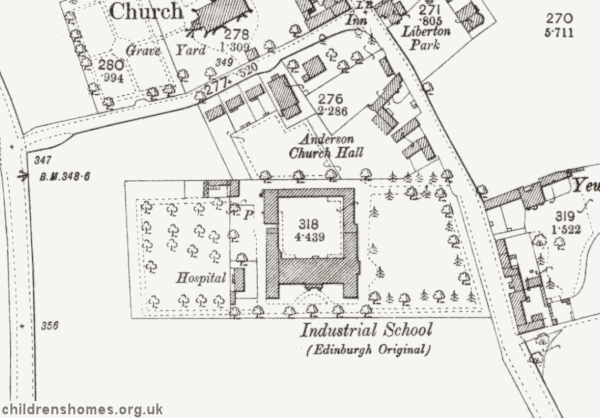
Edinburgh Original Industrial School for Boys site, Liberton, c.1894.
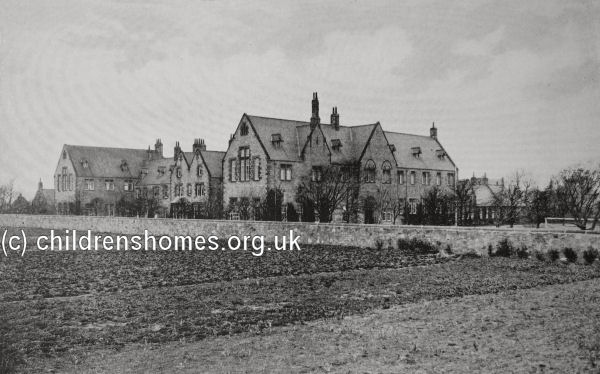
Edinburgh Original Industrial School for Boys, from the south-east, early 1900s. © Peter Higginbotham
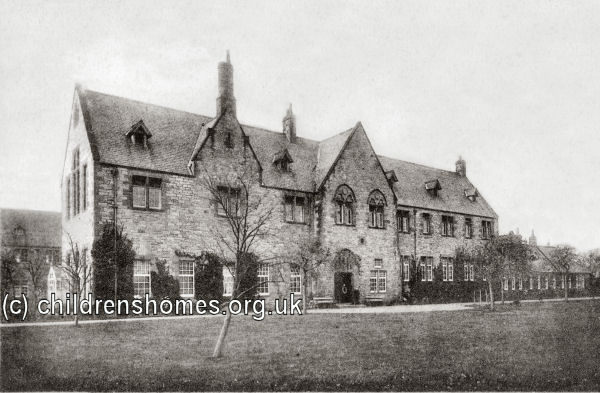
Edinburgh Original Industrial School for Boys, from the south-east, early 1900s. © Peter Higginbotham
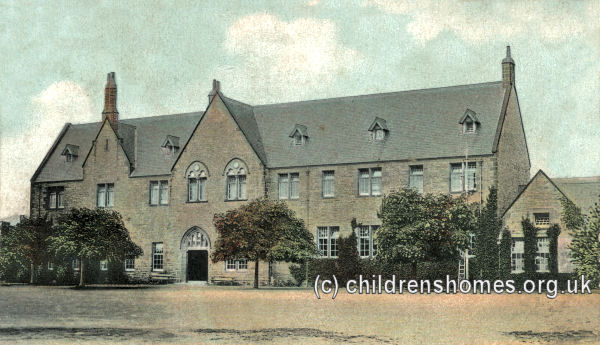
Edinburgh Original Industrial School for Boys, from the north-east, early 1900s. © Peter Higginbotham
The transfer to the new site took place on Friday 6 May. At 4p.m., the boys, with their band and pipers, numbering 210 in total, and ranging from 6 to 15 years of age, mustered in the Ramsay Lane. The band having played "Auld Lang Syne", the boys marched to the strains of the brasses and the pipes, arriving at their new quarters at about 5.20p.m. After reaching their destination, the boys had coffee served out to them, and the rest of the evening was devoted to putting the new dormitories into order.
The new buildings, designed by Mr Sydney Mitchell in the domestic Gothic style of architecture, were constructed in a reddish stone around a drill ground measuring 100 feet square. The main building and the principal portions of the wings on the east and west sides were two storeys in height, while those on the north of the square and north-east and north-west of the quadrangle were of one storey. The superintendent's house effectively divided the main building into two, with the older boys located in the east wing under the care of male officials, and the junior boys in the west wing, under the oversight of female staff. On the ground floor of the west wing were the kitchen, scullery, stores, etc., while the lower floor of the opposite wing contained the large schoolroom, divided into two by sliding panels. The dormitories occupied the upper floor, and featured high-pitched open timber roofs. In the range of one-storey buildings were the workshops, where tailoring, shoe-making and carpentry were to be carried on. The boys were now also to be taught gardening in the 1.5 acres of garden ground, with vegetables being grown for the institution and flowers cultivated for sale in the market. At the north-west corner of the quadrangle were a laundry, washing-house and engine-house, with tall chimney stack. A plentiful supply of steam was provided to cook the food and to heat the water in the bathrooms and washroom. Detached from the rest of the building was a small hospital for the treatment of infectious diseases, with convalescent room adjoining; a sick room was also provided in the main building. On one side, fronting the roadway was a large grass-covered playground. The new premises could accommodate up to 200 boys, aged from 6 to 10 years at their date of admission. Along with the boys, Mr William Henderson, who had been associated with the institution for over thirty years, transferred to the new site as superintendent, with Mrs Henderson continuing as matron and Thomas Lawson as assistant superintendent.
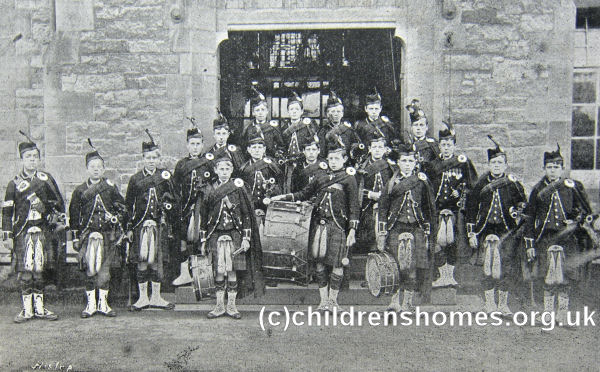
Boys' band at the Original Industrial School for Boys (Dr Guthrie's), Liberton, Edinburgh, c.1899. © Peter Higginbotham
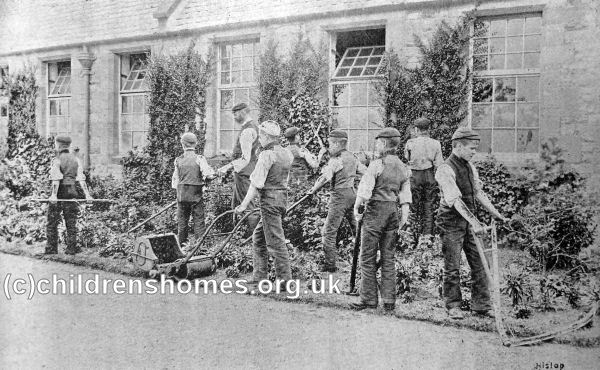
Boys gardening at the Original Industrial School for Boys (Dr Guthrie's), Liberton, Edinburgh, c.1899. © Peter Higginbotham
William Henderson finally retired from his post at the end of 1903, after 49 years of service. Mr Alex Russel was then appointed as superintendent.
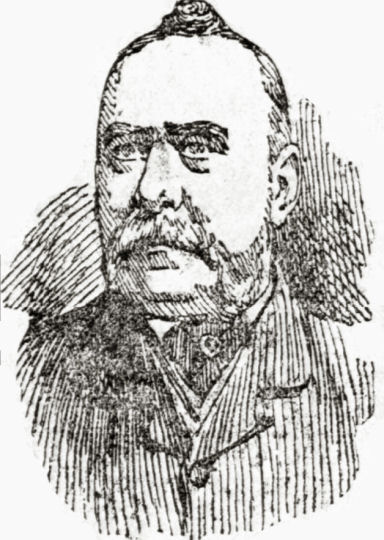
William Henderson, long-time superintendent of Liberton Industrial School.
In 1904, a gymnasium was constructed. The school football team was now playing fixtures against outside teams in the area. Industrial work mainly consisted of tailoring, shoe-making and joinery, with drawing also being taught. The following year, manual instruction instruction in woodwork was introduced.
By 1932, a swimming bath had been erected at the north-west of the main building.
In 1933, Liberton became an Approved School, one of the new institutions introduced by the Children and Young Persons (Scotland) Act to replace the existing system of Reformatories and Industrial Schools. It then accommodated up to 150 Junior Boys, aged from 10 to 12 years at their date of admission.
During the Second World War, the school was evacuated to St Ninian's at Moffat, Dumfriesshire. In 1943, it was described as providing practical instruction in woodwork, shoemaking, cookery and gardening. The band was still active. The headmaster was now Mr A.J. McAllister.
The 1968 Social Work (Scotland) Act aimed to bring Approved Schools in Scotland under the control of local authority social work departments. As a result of a title in a list drawn up by the Scottish Education Department, Liberton became referred to as a 'List D' school. Following a decline in numbers being placed at the school, it finally closed on 31 March 1985. The property was subsequently used as a nursing home but has now been converted to residential use.
Records
Note: many repositories impose a closure period of up to 100 years for records identifying individuals. Before travelling a long distance, always check that the records you want to consult will be available.
- National Records of Scotland, HM General Register House, 2 Princes Street, Edinburgh EH1 3YY. Holdings include: Admission registers (1849-1971); Admission papers, boys (1861-1936); Case files, boys (1940-1981); Committal orders, girls (1876-1899); Record books, boys (1875-1956); Licensing registers: boys (1962-70), girls (1964-70); Log books: boys (1969-1977), girls (1955-1986); Discharge registers (1879-1961); Visitors' books: boys (1859-1954), girls (1961-1984); Photographs (1930s-1970s); Minutes of meetings (1870-1965); Annual reports (1878-1986); Various administrative and financial records etc.
Bibliography
- Higginbotham, Peter Children's Homes: A History of Institutional Care for Britain's Young (2017, Pen & Sword)
- Mahood, Linda Policing Gender, Class and Family: Britain, 1850-1940 (1995, Univeristy of Alberta Press)
- Prahms, Wendy Newcastle Ragged and Industrial School (2006, The History Press)
Links
- None identified at present.
Except where indicated, this page () © Peter Higginbotham. Contents may not be reproduced without permission.


